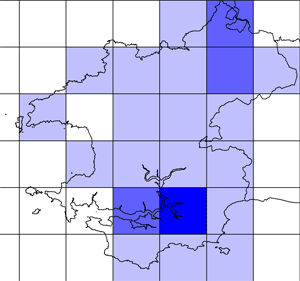Coal Tit - autumn irruptions
 Sunday, June 28, 2020 at 2:43PM
Sunday, June 28, 2020 at 2:43PM Parus ater - TITW PENDDU - Breeding resident, unusual on the islands
Although basically a sedentary species, the coal tit is prone to irruptive/eruptive behaviour following particularly good breeding seasons. In such years, they are often seen along the open coast, and even reach the offshore islands, usually in October. During a large irruption of tits in 1957, more than 100 coal tits passed through Skokholm.
More recent such occurrences include:
1988 - Unusually high numbers reported after the breeding season, when many joined mixed tit flocks on the open coast and penetrated to both Skomer and Skokholm
1989 - Up to 15 seen at Skomer 30 Sept - 23 Oct and 4 reached Skokholm on 12 Oct.
1991 - Reached Skomer in greater than usual numbers, & total of 171 bird-days logged Sept-Nov. Up to 15 also reached Skokholm.
1994 - Island records: Skomer 22,23,& 25 September with a max of 10; one Skokholm 15 Oct; 3 Ramsey 11 Oct
1997 - Eruptive and irruptive from Sept, when many flocks Seen around the coast at places like Strumble Head, Porthclais, St. Bride's and Castlemartin, with up to 170 reaching Ramsey, up to 14 Skomer and one Skokholm. Several exhibited the bluish-grey mantles of the Fenno-Scandian form, P. a. ater but most showed the olive-grey of P. a. britannicus.
1999 - One reached Ramsey 24 Oct; singles Skomer 24 June, 5-6 Oct, 25 Oct and I Nov, with 7 on 14 Oct and up to 9 between 17 & 20 Oct.
2001 - 1-4 reached Skomer on 11 dates, 21 Sept – 20 Oct (JGB), and singles Ramsey on 6 dates, 25 Sept – 20 Oct (SA)
2003 - Oct passage noted from Skomer and Ramsey. 50+ noted Porth Clais 3 Oct.
2008 - On Ramsey singles on 27 and 29 Sept, 3 Oct and 2nd Nov with 2 on 27th Oct and 3 on 1 Oct. This mini invasion represented the first records for 5 years. On Skomer: a single on September 25th. Three present on October 3rd and two on the 8th and 16th.
2010 - Three on Skomer on 7th and 12th Oct and two on 17th Oct, one on Ramsey on 9th Oct and two on the 11th Oct.
2015 - Max counts: 20 Dale Air Field on 25 Sept and 50 in off the sea on Ramsey on 30 Sept.
Records extracted from the Pembrokeshire Bird Reports
 Pembrokeshire Avifauna committee | Comments Off |
Pembrokeshire Avifauna committee | Comments Off |  Coal Tit
Coal Tit 






